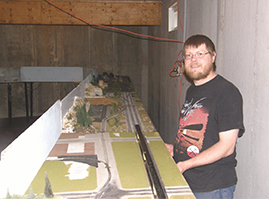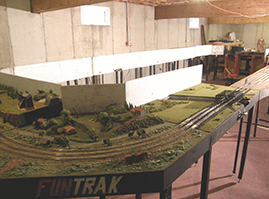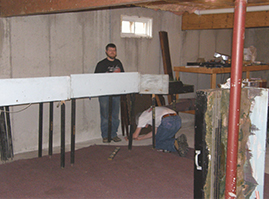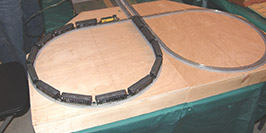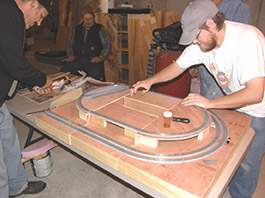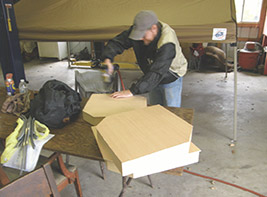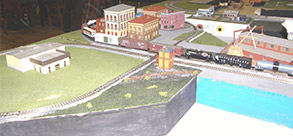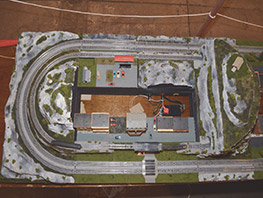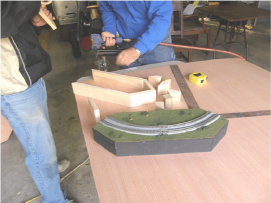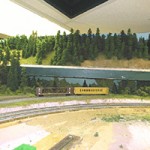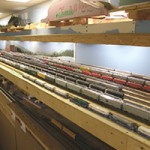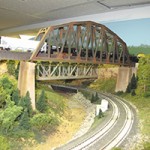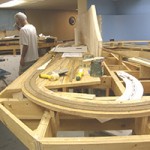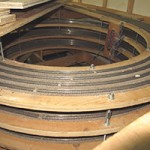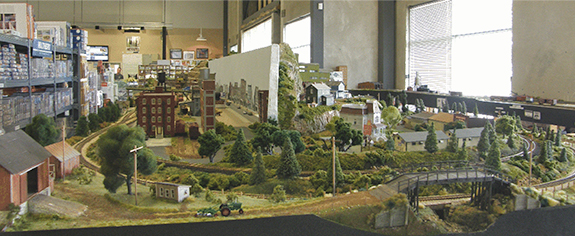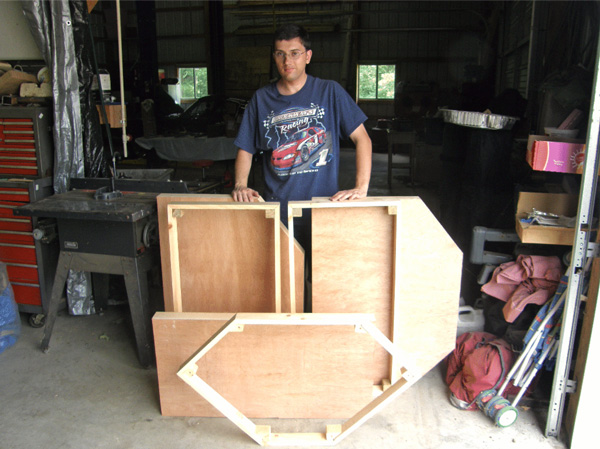Layout Design
Working together!
T-Trak Progression
|
The photos at left illustrate the before and after of the t-trak modules FUNTRAK has built over the past few years. These modules are a testament to the remarkable talent available from FUNTRAK members in recreating a visual spectacle everyone can appreciate. Lorenzo comes up with some new and exciting ideas, John assists in scenicking the modules with his creative talents, and FUNTRAK members reap the benefits of the public’s admiration for these terrific displays. The combination of innovation, creativity, and talent is a winning situation for FUNTRAK and those fortunate enough to see these fabulous works of art. |
FUNTRAK at FFC
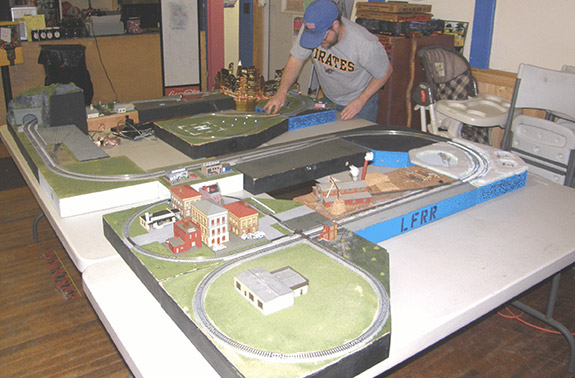
FUNTRAK club member John Fleming assembles another t-trak unique layout at the Family Fun Center in Mohawk where FUNTRAK conducted its March monthly meeting. John has been responsible for much of the scenery work on many of the recent modules FUNTRAK has constructed. His artistic talent is truly “magic” on many of these wonderful modules. More examples of the before and after effect of John’s handiwork are illustrated inside. Keep up the great work, John!
Time to get to work!
Lots of hard work goes into building train layouts. But, our club members are so into their hobby that it’s not even like “work” at all!
Check this out!
On a recent visit up to Canada, Brian had the opportunity to revisit a few home layouts. Excellent layouts included Justin’s, Walter’s and new this year, John Johnston’s. Justin Parry’s layout is featured above; John Johnson’s is featured below. These layouts all illustrate the craftsmanship and hard work that goes into building a quality model railroad.
Credit Valley Railway Revisited
The layout featured above can be seen at Credit Valley Railway, the hobby shop located in Mississauga, Canada. The layout illustrates what can be done with available supplies, of which the hobby shop carries everything needed to build this fine layout. On a recent visit, Brian found the selection at the store was wonderful, the help most gracious, and prices reasonable. Many hard to find and unusual items were readily available and easy to find in the well organized store. If you are in the area, do not pass up an opportunity to visit this fine Canadian hobby shop.
Steadily persevering
Brian, in conjunction with Mark Bean and David King, has been steadily persevering at the software program to operate the reverse loop for the N scale T-trak one trak project. It seems that the simplest things are not as simple as they might at first appear. The overall concept of the reverse loop is to have a train enter going in one
direction and exit going in the opposite direction. Automating this means that the software has to recognize where the train is at any given time, what the power requirements are at that time, and changing any necessary hardware to
accommodate the train as it moves along. All this is pretty straightforward, but implementing it with the software and getting it to operate the way it is planned is nowhere near as simple as it sounds.
First, the hardware does not always cooperate. Checking the polarity is not always reliable, so the software needs to
be written to compensate for possible misreadings. Then the magnetic sensors have to be checked and again compensated for any misreadings. Finally, all the action has to be timed perfectly, and put together in one complete package designed to operate without failure. Sounds easy enough but in reality, it is much more difficult and mostly, time
consuming than it at first would appear. Persistence is the order of the day and Mark, David, and Brian will keep at it
until finished. A photo of the temporary setup is pictured below.
HO building continues
That’s one dedicated club member!
FUNTRAK member Greg Brockway is finding out that it can be lonely at the top. Greg has been diligently constructing HO scale T-trak modules for display at FUNTRAK functions with very little help. He did manage to get some assistance recently at Brian’s when they worked together to construct two specialty one-trak style modules and one more double to incorporate into future layouts. Greg has been and continues to be the mainstay for thre HO division of FUNTRAK. Please note Greg, your efforts have not gone unnoticed. Keep up the great work!
From the Desk: June 2013
Welcome to Spring, replete with eighty degree weather one day and snow the next. At least this gives FUNTRAK members a reason to try and keep warm and build new modules. That’s exactly what members John Fleming, Jim Domser, Lorenzo Franchi, and Brian King did on Sunday, May 19th. After a highly successful meeting on May 7th, which included new members Bill Whittaker and Bill McComb, plans were finalized to construct the new reverse end loop for the N scale one trak t-trak layouts. Future plans for building more HO scale t-trak modules were decided and construction on those will begin in the near future. A general consensus found that most people favored the double length modules for HO since the single modules were more difficult to scenic. Sometimes, more is better. Construction of the N scale loop modules went well and track was laid on the three corner modules. The specialty module could not have track laid yet because all the sensors and electrical devices were not finalized at this time. This project has entailed getting help and advice from Canada, Australia, Syracuse, and Rochester. There is a lot more to automating a conventional reverse loop than at first meets the eye.
FUNTRAK will be using an Arduino micro controller to control all the necessary electrical and electronic actions involved in this endeavor. Brian has been tasked with coordinating all the programming and installation of the required devices to make this project work. Without the assistance of Mark Bean in Australia, the programming would not have progressed as far as it has. David King from Canada lent his expertise in overcoming some of the electrical anomalies while Jeff Faust in Rochester has contribute his knowledge to help out with the project. Of course, our friend Rich Pettito in Syracuse contributed to the beginning of all this when he donated a beautifully scenicked diorama that has the single track of one trak on it. This is what got most of this started. Thanks Rich!
As the pictures show, the construction went very well. The modules were cut, assembled, and the track laid down in relatively short order. Some minor adjustments and everything was ready to be tested. The small locomotives designed to be operated on the tight radius loop were tested and a few cars were run around the loop to make sure the track work was satisfactory. All seemed to work properly for the tests. Now we will see how everything goes when all the other equipment is installed. The critical part will be getting the software to do the right things in the right order. Time will tell. It seems FUNTRAK is not the only club with that ever had lenient “rules”. Club member John Quinn provided some insight into the “rules” of one of the former clubs he was a member of a few years back.
“Ties and Rail” Railroad Club Rules were as follows:
1) Anyone who loves trains, and agrees to these rules, is immediately created a vice-president.
2) Meetings are held whenever two members are sober enough to recognize each other.
3) Any member who tries to create any more rules or hold a business meeting is automatically expelled.
Seems reasonable to me. A little tongue in cheek is always nice to keep things on the light-hearted side. Thanks for sharing these rules with us, John. Maybe FUNTRAK can incorporate some of them into our constitution.
Upcoming events include a small HO setup at Dave’s Diner on June 25th. This is always a fun show for FUNTRAK since it is held outdoors and there are lots of other activities going on at the same time. The old cars, the DJ and music, the food, as well as the trains and camaraderie all contribute to a great evening of fun. Come on down and enjoy all the fun with us. See you there!
Brian


